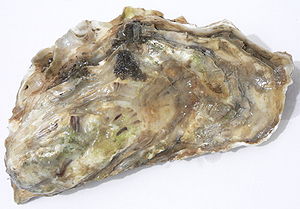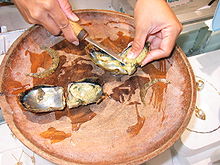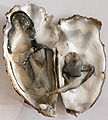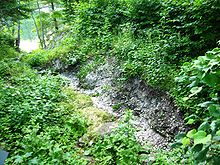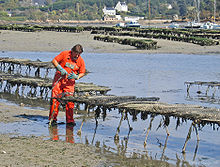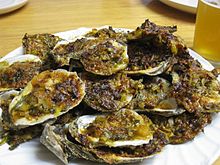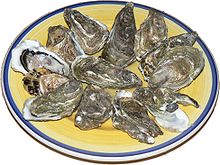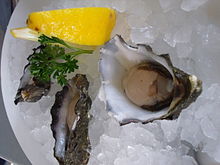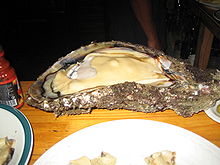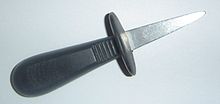- Oyster
-
The word oyster is used as a common name for a number of distinct groups of bivalve molluscs which live in marine or brackish habitats. The valves are highly calcified.
Some kinds of oyster are commonly consumed, cooked or raw, by humans. Other kinds, such as pearl oysters, are not. These are considered an aphrodisiac.
Contents
Etymology
First attested in English 14th century, the word oyster comes from Old French oistre, in turn from Latin ostrea, the feminine form of ostreum,[1] which is the latinisation of the Greek ὄστρεον (ostreon), "oyster".[2] Compare ὀστέον (osteon), "bone".[3]
Types
True oysters
True oysters are members of the family Ostreidae. This family includes the edible oysters, which mainly belong to the genera Ostrea, Crassostrea, Ostreola and Saccostrea. Examples include the Belon oyster, Eastern oyster, Olympia oyster, Pacific oyster, Sydney rock oyster, and the Wellfleet oyster.
Pearl oysters
Almost all shell-bearing molluscs can secrete pearls, yet most are not very valuable.
Pearl oysters are not closely related to true oysters, being members of a distinct family, the feathered oysters (Pteriidae). Both cultured pearls and natural pearls can be obtained from pearl oysters, though other molluscs, such as the freshwater mussels, also yield pearls of commercial value.
The largest pearl-bearing oyster is the marine Pinctada maxima, which is roughly the size of a dinner plate. Not all individual oysters produce pearls naturally. In fact, in a harvest of three tons of oysters, only three to four oysters produce perfect pearls.[citation needed]
In nature, pearl oysters produce natural pearls by covering a minute invading parasite with nacre, not by ingesting a grain of sand.[4] Over the years, the irritating object is covered with enough layers of nacre to become a pearl. There are many different types, colours and shapes of pearl; these qualities depend on the natural pigment of the nacre, and the shape of the original irritant.
Pearl farmers can culture a pearl by placing a nucleus, usually a piece of polished mussel shell, inside the oyster. In three to six years, the oyster can produce a perfect pearl. These pearls are not as valuable as natural pearls, but look exactly the same. In fact, since the beginning of the 20th century, when several researchers discovered how to produce artificial pearls, the cultured pearl market has far outgrown the natural pearl market.
Other types of oyster
A number of bivalve molluscs (other than edible oysters and pearl oysters) also have common names that include the word "oyster", usually because they either taste or look like oysters, or because they yield noticeable pearls. Examples include:
- Thorny oysters (Spondylidae)
- Pilgrim oysters (a kind of scallop)
- Saddle oysters (Anomia ephippium)
-
OysterBall.
Anatomy
Oysters are filter feeders, drawing water in over their gills through the beating of cilia. Suspended plankton and particles are trapped in the mucus of a gill, and from there are transported to the mouth, where they are eaten, digested and expelled as faeces or pseudofaeces. Oysters feed most actively at temperatures above 10 °C (50 °F). An oyster can filter up to 5 litres (1.3 US gal) of water per hour. Chesapeake Bay's once flourishing oyster population historically filtered excess nutrients from the estuary's entire water volume every three to four days. Today that would take nearly a year.[5] Excess sediment, nutrients, and algae can result in the eutrophication of a body of water. Oyster filtration can mitigate these pollutants.
In addition to their gills, oysters can also exchange gases across their mantle, which is lined with many small, thin-walled blood vessels. A small, three-chambered heart, lying under the adductor muscle, pumps colorless blood to all parts of the body. At the same time, two kidneys, located on the underside of the muscle, remove waste products from the blood.
While some oysters have two sexes (European Oyster & Olympia Oyster), their reproductive organs contain both eggs and sperm. Because of this, it is technically possible for an oyster to fertilize its own egg. The gonads surround the digestive organs, and are made up of sex cells, branching tubules and connective tissue.
Once the female is fertilized, they discharge millions of eggs into the water. The larvae develop in about six hours and swim around for about two to three weeks. After that, they settle on a bed and mature within a year. [29]
Habitat and behaviour
A group of oysters is commonly called a bed or oyster reef.
The largest oyster-producing body of water is located in Chesapeake Bay, although these beds are starting to decrease in number due to overfishing and pollution. Large beds of edible oysters are also found in Japan and Australia. [29]
As a keystone species, oysters provide habitat for many marine species. Crassostrea and Saccostrea live mainly in the intertidal zone, while Ostrea are subtidal. The hard surfaces of oyster shells and the nooks between the shells provide places where a host of small animals can live. Hundreds of animals such as sea anemones, barnacles, and hooked mussels inhabit oyster reefs. Many of these animals are prey to larger animals, including fish such as striped bass, black drum and croakers.
An oyster reef can increase the surface area of a flat bottom 50-fold. An oyster's mature shape often depends on the type of bottom to which it is originally attached, but it always orients itself with its outer, flared shell tilted upward. One valve is cupped and the other is flat.
Oysters usually reach maturity in one year. They are protandric; during their first year they spawn as males by releasing sperm into the water. As they grow over the next two or three years and develop greater energy reserves, they spawn as females by releasing eggs. Bay oysters usually spawn by the end of June. An increase in water temperature prompts a few oysters to spawn. This triggers spawning in the rest, clouding the water with millions of eggs and sperm. A single female oyster can produce up to 100 million eggs annually. The eggs become fertilized in the water and develop into larvae, which eventually find suitable sites, such as another oyster's shell, on which to settle. Attached oyster larvae are called spat. Spat are oysters less than 25 millimetres (0.98 in) long. Many species of bivalve, oysters included, seem to be stimulated to settle near adult conspecifics.
Some tropical oysters in the family Isognomonidae grow best on mangrove roots. Low tide can expose them, making them easy to collect. In Trinidad in the West Indies, tourists are often astounded when they are told that in the Caribbean, "oysters grow on trees".
Common oyster predators include crabs, sea birds, sea stars, and humans. Some oysters contain live crabs, known as oyster crabs.
Marine pollution
Oysters consume nitrogen-containing compounds (nitrates and ammonia), removing them from the water.[6] Nitrogen compounds are important phytoplankton nutrients. Phytoplankton increase water turbidity. Limiting the amount of phytoplankton in the water improves water quality and other marine life by reducing competition for dissolved oxygen. Oysters feed on plankton, incidentally consuming nitrogen compounds as well. They then expel solid waste pellets which decompose into the atmosphere as nitrogen.[4] In Maryland, the Chesapeake Bay Program plans to use oysters to reduce the amount of nitrogen compounds entering the Chesapeake Bay by 8,600 metric tons (19,000,000 lb) per year by 2010.[7]
The oyster-tecture movement, espoused by Assistant Professor Kate Orff of the Columbia University Graduate School of Architecture, promotes the use of oyster reefs for water purification and wave attenuation. As of 2011, coverage of the Gowanus Canal Parade of Oyster Spats is unavailable.[8] An "Oyster-tecture" project has been implemented at Withers Estuary, Withers Swash, South Carolina, by Neil Chambers-led volunteers, at a site where pollution was impacting beach tourism. Currently, for the installation cost of $3000, roughly 4.8 million liters of water is being filtered daily. In New Jersey, however, oyster-tecture is faring less well. The Department of Environmental Protection refused to allow oysters as a filtering system in Sandy Hook Bay and the Raritan Bay citing worries that commercial shellfish growers would be at risk and that members of the public might disregard warnings and consume tainted oysters.
Human history
The Whaleback Shell Midden in Maine contains the shells from oyster harvesting for food consumption dating to 2200-1000 years ago
Middens testify to the prehistoric importance of oysters as food. In the United Kingdom, the town of Whitstable is noted for oyster farming from beds on the Kentish Flats that have been used since Roman times. The borough of Colchester holds an annual Oyster Feast each October, at which "Colchester Natives" (the native oyster, Ostrea edulis) are consumed. The United Kingdom hosts several other annual oyster festivals, for example Woburn Oyster Festival is held in September. Many breweries produce Oyster Stout, a beer intended to be drunk with oysters that sometimes includes oysters in the brewing process.
The French seaside resort of Cancale is noted for its oysters, which also date from Roman times. Sergius Orata of the Roman Republic is considered the first major merchant and cultivator of oysters. Using his considerable knowledge of hydraulics, he built a sophisticated cultivation system, including channels and locks, to control the tides. He was so famous for this that the Romans used to say he could breed oysters on the roof of his house.[9]
The world-famous Clarenbridge and Galway Oyster Festivals take place in Galway, Ireland each September. In Ireland it is traditional to eat them live with Guinness and buttered brown soda bread.
In the early 19th century, oysters were cheap and mainly eaten by the working class. Throughout the 19th century, oyster beds in New York harbor became the largest source of oysters worldwide. On any day in the late 19th century, six million oysters could be found on barges tied up along the city’s waterfront. Oysters were naturally quite popular in New York City, and helped initiate the city’s restaurant trade.[10] New York's oystermen became skilled cultivators of their beds, which provided employment for hundreds of workers and nutritious food for thousands. Eventually, rising demand exhausted many of the beds. To increase production, they introduced foreign species, which brought disease, when combined with effluent and increasing sedimentation from erosion, which destroyed most of the beds by the early 20th century. Oysters’ popularity has put an ever-increasing demands on wild oyster stocks.[11] This scarcity increased prices, converting them from their original role as working class food to their current status as an expensive delicacy.
In the United Kingdom, the native variety (Ostrea edulis) is still held to be the finest,[by whom?] requiring five years to mature and protected by an Act of Parliament during the May–August spawning season. The current market is dominated by the larger Pacific oyster and rock oyster varieties which are farmed year round.
Commercial fishing
Fishing from the wild
Oysters are harvested by simply gathering them from their beds. In very shallow waters they can be gathered by hand or with small rakes. In somewhat deeper water, long-handled rakes or oyster tongs are used to reach the beds. Patent tongs can be lowered on a line to reach beds that are too deep to reach directly. In all cases the task is the same: the oysterman scrapes oysters into a pile, and then scoops them up with the rake or tongs.
In some areas a scallop dredge is used. This is a toothed bar attached to a chain bag. The dredge is towed through an oyster bed by a boat, picking up the oysters in its path. While dredges collect oysters more quickly, they heavily damage the beds, and their use is highly restricted. Until 1965 Maryland limited dredging to sailboats, and even since that date motor boats can be used only on certain days of the week. These regulations prompted the development of specialized sailboats (the bugeye and later the skipjack) for dredging.
Oysters can also be collected by divers.
In any case, when the oysters are collected, they are sorted to eliminate dead animals, bycatch (unwanted catch), and debris. Then they are taken to market where they are either canned or sold live.
Cultivating oysters
Oysters have been cultured for well over a century. Two methods are commonly used, release and bagging. In both cases oysters are cultivated onshore to the size of spat, when they can attach themselves to a substrate. They may be allowed to mature further to form seed oysters. In either case they are then placed in the water to mature. The release technique involves distributing the spat throughout existing oyster beds allowing them to mature naturally to be collected like wild oysters. Bagging has the cultivator putting spat in racks or bags and keeping them above the bottom. Harvesting involves simply lifting the bags or rack to the surface and removing the mature oysters. The latter method prevents losses to some predators, but is more expensive.[12]
The Pacific or Japanese oyster, Crassostrea gigas has been grown in the outflow of mariculture ponds. When fish or prawn are grown in ponds, it takes, typically 10 kilograms (22 lb) of feed to produce 1 kilogram (2.2 lb) of product (dry-dry basis). The other 9 kilograms (20 lb) goes into the pond and after mineralization, provides food for phytoplankton, which in turn feeds the oyster.
To prevent spawning, sterile oysters are now cultured by crossbreeding tetraploid and diploid oysters. The resulting triploid oyster cannot propagate, which prevents introduced oysters from spreading into unwanted habitats.[13]
Restoration and recovery
In many areas non-native oysters have been introduced in attempts to prop up failing harvests of native varieties. For example, the eastern oyster was introduced to California waters in 1875, while the Pacific oyster was introduced there in 1929.[14] Proposals for further such introductions remain controversial.
The Pacific oyster prospered in Pendrell Sound where the surface water is typically warm enough for spawning in the summer. Over the following years, spat spread out sporadically and populated adjacent areas. Eventually, possibly following adaptation to the local conditions, the Pacific oyster spread up and down the coast and now is the basis of the North American west coast oyster industry. Pendrell Sound is now a reserve that supplies spat for cultivation.[15] Near the mouth of the Great Wicomico River in the Chesapeake Bay, five year-old artificial reefs now harbor more than 180 million native Crassostrea virginica. That is still a far cry from the late 1880s, when the Bay’s population was in the billions, and watermen harvested about 910,000 cubic metres (25,000,000 imp bsh) annually. The 2009 harvest was less than 7,300 cubic metres (200,000 imp bsh). Researchers claim that the keys to the project were:
- using waste oyster shells to elevate the reef floor 25–45 centimetres (9.8–18 in) to keep the spat free of bottom sediments
- building larger reefs, ranging up to 8.1 hectares (20 acres) in size
- disease resistant broodstock[16]
In 2005, China accounted for 80% of the global oyster harvest.[17] Within Europe, France remained the industry leader.
Oysters as food
Jonathan Swift is quoted as having said, "He was a bold man that first ate an oyster",[18] but evidence of oyster consumption goes back into prehistory, evidenced by oyster middens found worldwide. Oysters were an important food source in all coastal areas where they could be found, and oyster fisheries were an important industry where they were plentiful. Overfishing and pressure from diseases and pollution have sharply reduced supplies, but they remain a popular treat celebrated in oyster festivals in many cities and towns.
There are several different types of oysters that are edible out of the over 50 different kinds that are in the oceans today.[29]
Nutrition
Oysters are an excellent source of zinc, iron, calcium, selenium as well as Vitamin A and Vitamin B12. Oysters are low in food energy; one dozen raw oysters contain approximately 110 kilocalories (460 kJ). Oysters are considered the healthiest when eaten raw on the half shell.[19]
Traditionally, oysters were considered to be an aphrodisiac.[20] A team of American and Italian researchers analyzed bivalves and found they were rich in amino acids that trigger increased levels of sex hormones.[21] Their high zinc content aids the production of testosterone.[10]
Dietary supplements may contain calcium carbonate from oyster shells, though there is no evidence that this offers any benefits beyond what calcium may offer.
Selection, preparation and storage
Unlike most shellfish, oysters can have a fairly long shelf life: up to two weeks. However, their taste becomes less pleasant as they age. Oysters should be refrigerated out of water, not frozen and in 100% humidity. Oysters stored in water under refrigeration will open, consume available oxygen and die. Oysters must be eaten alive, or cooked alive. The shells of live oysters are normally tightly closed or snap shut given a slight tap. If the shell is open, the oyster is dead, and cannot be eaten safely. Cooking oysters in the shell kills the oysters and causes them to open by themselves. Oysters that don’t open were dead before cooking and are unsafe.[22]
Oysters can be eaten on the half shell, raw, smoked, boiled, baked, fried, roasted, stewed, canned, pickled, steamed, broiled or used in a variety of drinks. Preparation widely varies. It can be as simple as opening the shell and eating the contents, including juice. Butter and salt are often added. In the case of oysters Rockefeller, preparation can be very elaborate. They are sometimes served on edible seaweed, such as brown algae.
Care should be taken when consuming oysters. Purists insist on eating them raw, with no dressing save perhaps lemon juice, vinegar (most commonly shallot vinegar), or cocktail sauce. Upscale restaurants pair raw oysters with a home-made Mignonette sauce, which consists primarily of fresh chopped shallot, mixed peppercorn, dry white wine and lemon juice or sherry vinegar. Like fine wine, raw oysters have complex flavors that vary greatly among varieties and regions: sweet, salty, earthy, or even melon. The texture is soft and fleshy, but crisp on the palate. North American varieties include: Kumamoto and Yaquina Bay from Oregon State, Malpeque from Prince Edward Island, Canada, Blue Point from Long Island, New York, and Cape May oysters from New Jersey. Salinity, mineral, and nutrient variations in the water that nurtures them influence their flavor profile.
It was once assumed that oysters were only safe to eat in months with the letter ‘r’ in their English and French names. This is a myth whose basis in truth is that in the northern hemisphere oysters are much more likely to spoil in May, June, July, and August.[23]
Oysters can contain harmful bacteria. Oysters are filter feeders and will naturally concentrate anything present in the surrounding water. Oysters from the Gulf Coast of the United States, for example, contain high bacterial loads of human pathogens in the warm months, most notably Vibrio vulnificus and Vibrio parahaemolyticus. In these cases, the main danger is for immuno-compromised individuals, who are unable to fight off infection and can succumb to septicemia, leading to death. Vibrio vulnificus is the most deadly seafood-borne pathogen, with a higher case-to-death ratio than even Salmonella enterica and Escherichia coli.[citation needed]
Opening oysters
Fresh oysters must be alive just before consumption or cooking. There is only one criterion: the oyster must be capable of tightly closing its shell. Open oysters should be tapped on the shell; a live oyster will close up and is safe to eat. Oysters which are open and unresponsive are dead and must be discarded. Some dead oysters, or oyster shells which are full of sand may be closed. These make a distinctive noise when tapped, and are known as clackers.
Opening oysters requires skill. The preferred method is to use a special knife (called an oyster knife, a variant of a shucking knife), with a short and thick blade about 5 centimetres (2.0 in) long.
While there are different methods to open an oyster (which sometimes depend on the type of oyster), the following is one commonly accepted oyster shucking method. Insert the blade, with moderate force and vibration if necessary, at the hinge between the two valves. Then twist the blade until there is a slight pop. Then slide the blade upward to cut the adductor muscle which holds the shell closed. Inexperienced shuckers can apply too much force, which can result in injury if the blade slips. Heavy gloves are necessary: apart from the knife, the shell itself can be razor sharp. Professional shuckers require less than 3 seconds to do the deed.[10]
If the oyster has a particularly soft shell, the knife can be inserted instead in the sidedoor, about halfway along one side where the oyster lips widen and there is a slight indentation.
Opening or "shucking" oysters has become a competitive sport. Oyster shucking competitions are staged around the world. Widely acknowledged to be the premiere event, the Guinness World Oyster Opening Championship is held in September at the Galway Oyster Festival, in Galway Ireland.
Ethical considerations
See also: Pain in crustaceansThe oyster is considered by some ethicists[24] to be an appropriate food choice for those concerned with animal rights, arguing it is acceptable to eat oysters due to their lack of a central nervous system and the generally sustainable and environmentally friendly way in which they are raised and harvested.
One common ethical objection to the consumption of animals is that their cultivation is environmentally harmful. Regarding environmental impact, 95% of oysters are sustainably farmed and harvested (other bivalves are frequently harvested by harmful dredging), feed on plankton (very low on the food chain), and in fact improve the marine environment by removing toxins. As such, oysters are listed as a "Best Choice" (highest rating) on the Seafood Watch list.[25]
The view that oysters are acceptable to eat, even by strict ethical criteria, has notably been propounded in the seminal 1975 text Animal Liberation, by philosopher Peter Singer However, subsequent editions have reversed this position (advocating against eating oysters). Singer has stated that he has "gone back and forth on this over the years", and as of 2010 states that "while you could give them the benefit of the doubt, you could also say that unless some new evidence of a capacity for pain emerges, the doubt is so slight that there is no good reason for avoiding eating sustainably produced oysters".[26]
Diseases
Oysters are subject to various diseases which can reduce harvests and severely deplete local populations. Disease control focuses on containing infections and breeding resistant strains and is the subject of much ongoing research.
- Dermo (Perkinsus marinus) is caused by a protozoan parasite. It is a prevalent pathogen, causes massive mortality and poses a significant economic threat to the oyster industry. The disease is not a direct threat to humans consuming infected oysters.[27] Dermo first appeared in the Gulf of Mexico in the 1950s, and until 1978 it was believed to be caused by a fungus. While it is most serious in warmer waters, it has gradually spread up the east coast of the United States.[28]
- MSX (Multinucleated Sphere X) is caused by the protozoan Haplosporidium nelsoni, generally seen as a multi-nucleated plasmodium. It is infectious and causes heavy mortality in the Eastern Oyster; survivors, however, develop resistance and can help propagate resistant populations. MSX is associated with high salinity and water temperatures.[27] MSX was first noted in Delaware Bay in 1957 and is now found all up and down the east coast of the United States. Evidence suggests that it was brought to the United States when Crassostrea gigas, a Japanese oyster variety, was introduced to Delaware Bay.[28]
See also
- Auckland oyster
- Belon oyster
- Bluff oyster
- Eastern oyster
- Olympia oyster
- Ostrea angasi (Australian southern mud or native flat oyster)
- Oyster cracker
- Oyster farming
- Oyster festival
- Oysters Kirkpatrick (classic recipe and minor English literary character)
- Oyster omelette
- Oyster pail
- Oyster sauce
- Oysters Rockefeller
- Pacific oyster
- Pearl
- Pearl oyster
- Red tide
- Rolled oyster
- Rock oyster
- Sydney rock oyster
- Shellder
- Tabby (cement)
Footnotes
- ^ ostrea, ostreum, Charlton T. Lewis, Charles Short, A Latin Dictionary, on Perseus
- ^ ὄστρεον, Henry George Liddell, Robert Scott, A Greek-English Lexicon, on Perseus
- ^ ὀστέον, Henry George Liddell, Robert Scott, A Greek-English Lexicon, on Perseus
- ^ a b "A dozen ocean-cleaners and a pint of Guinness, please". The Economist. 2008-12-18. http://www.economist.com/world/unitedstates/displaystory.cfm?story_id=12795573. Retrieved 2008-12-26.
- ^ "Oyster Reefs: Ecological importance". US National Oceanic and Atmospheric Administration. http://habitat.noaa.gov/restorationtechniques/public/habitat.cfm?HabitatID=2&HabitatTopicID=11. Retrieved 2008-01-16.
- ^ "Oyster Culture is Good for the Environment". East Coast Shellfish Growers Association. http://www.ecsga.org/libraryitems/newsoyster.htm. Retrieved 2008-12-26.[dead link]
- ^ "Oyster Restoration Projected to Provide Significant Boost to Bay Grasses While Removing Nitrogen Pollution from the Bay". Maryland Department of Natural Resources. http://www.dnr.state.md.us/dnrnews/pressrelease2005/081505.html. Retrieved 2008-12-26.
- ^ GrrlScientist (2011-02-03). "Oyster-tecture: Reviving New York City's rivers with oysters". The Guardian. http://www.guardian.co.uk/science/punctuated-equilibrium/2011/feb/03/1. Retrieved 2011-08-16.
- ^ Holland, Tom (2003). Rubicon. ISBN 038550313X.
- ^ a b c Kurlansky, Mark (2006). The Big Oyster: History on the Half Shell.. New York: Ballantine Books. ISBN 978-1-588-591-0.
- ^ Clover, Charles (2004). The End of the Line: How overfishing is changing the world and what we eat. London: Ebury Press. ISBN 0-09-189780-7.
- ^ "Oyster Farming in Louisiana" (PDF). Louisiana State University. http://www.lamer.lsu.edu/classroom/edonahalfshell/pdf/cycle_info.pdf. Retrieved 2008-01-16.
- ^ Nell J. A. (2002). "Farming triploid oysters". Aquaculture 210: 69–88. doi:10.1016/S0044-8486(01)00861-4.
- ^ Conte, Fred S.. "California Oyster Culture" (PDF). University of California, Davis Department of Animal Science. Archived from the original on 2007-12-01. http://web.archive.org/web/20071201091053/http://aqua.ucdavis.edu/dbweb/outreach/aqua/ASAQ-A07.PDF. Retrieved 2008-01-16.
- ^ "Shellfish Tenures Locations Map". http://bcsga.ca/?page_id=110. Retrieved 2008-01-16.
- ^ Fountain, Henry (August 3, 2009). "Oysters Are on the Rebound in the Chesapeake Bay". The New York Times. http://www.nytimes.com/2009/08/04/science/04oyster.html. Retrieved August 25, 2009.
- ^ "China harvests almost 4m tonnes of oyster in 2005". http://www.fao.org/figis/servlet/SQServlet?file=/usr/local/tomcat/FI/5.5.23/figis/webapps/figis/temp/hqp_30190.xml&outtype=html.
- ^ Polite Conversations, 1738, cited e.g. in "Oyster Heaven". Wilmington Magazine (Wilmington Star-News). November 24, 2004. http://www.starnewsonline.com/apps/pbcs.dll/article?AID=/20041124/MAGAZINE53/41129007/-1/magazine50&template=printart. Retrieved 2008-01-16.
- ^ "Nutrition Facts and Analysis for Mollusks, oyster, eastern, wild, raw". Nutritiondata.com. http://www.nutritiondata.com/facts/finfish-and-shellfish-products/4189/2. Retrieved 2011-08-16.
- ^ Stott, Rebecca (2004). "Oyster". The University of Chicago Press. http://www.press.uchicago.edu/cgi-bin/hfs.cgi/00/165121.ctl. Retrieved 2008-01-16.
- ^ "Pearly wisdom: oysters are an aphrodisiac". The Sydney Morning Herald. 2005-03-24. http://www.smh.com.au/articles/2005/03/23/1111525227607.html.
- ^ "Oysters". i love blue sea. 2010-07-15. http://www.ilovebluesea.com/blog/oysters/. Retrieved 2011-08-16.
- ^ "Nefsc Fish Faq". Nefsc.noaa.gov. 2011-06-16. http://www.nefsc.noaa.gov/faq/fishfaq5b.html. Retrieved 2011-08-16.
- ^ Singer, Peter (1975). Animal Liberation, A New Ethics for our Treatment of Animals. New York: Random House.
- ^ "Oysters – Seafood Watch". Montereybayaquarium.org. http://www.montereybayaquarium.org/cr/SeafoodWatch/web/sfw_factsheet.aspx?fid=82. Retrieved 2011-08-16.
- ^ Cox, Christopher (April 7, 2010). "Consider the Oyster: Why even strict vegans should feel comfortable eating oysters by the boatload". Slate. http://www.slate.com/id/2248998/. Retrieved 2010-04-12.
- ^ a b "Oyster Diseases". Connecticut Department of Agriculture. http://www.ct.gov/doag/cwp/view.asp?a=1369&q=259180. Retrieved 2008-01-16.
- ^ a b "MSX/Dermo". Chesapeake Bay Program. http://www.chesapeakebay.net/oysterdiseases.aspx?menuitem=19507. Retrieved 2009-04-05.
29. OYSTER. Retrieved from Funk & Wagnalls New World Encyclopedia database.
External links
- World of Boats (EISCA) Collection ~ Fal Oyster Boat, Sunny South
- Oysters grown on trestles in Ireland
- Nutrition Facts for Oysters
- Oyster farming in the Rivers Crouch, Roach and Blackwater of Eastern Essex
Commercial mollusks Marine gastropods - Abalone
- Periwinkle
- Whelk
- Buccinum undatum
- Bullacta exarata
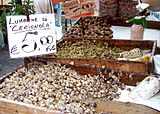
Land and freshwater gastropods - Helix pomatia
- Helix aspersa
- Helix aperta
- Cepaea nemoralis
- Otala lactea
- Escargot
Free-swimming marine bivalves - Scallop
- Queen scallop
- Pecten maximus
- Pecten jacobaeus
- Argopecten irradians
- Placopecten magellanicus
Infaunal bivalves - Clam
- Mercenaria mercenaria
- Austrovenus stutchburyi
- Saxidomus nutalli
- Arctica islandica
- Cockle
- Geoduck
- Spisula solidissima
- Paphies ventricosa
- Paphies australis
- Tuatua
- Ruditapes largillierti
- Grooved carpet shell
Sessile bivalves - Oyster
- Mussel
- Pearl oyster
Freshwater bivalves Cephalopods Techniques Principal commercial fishery species groups Wild Forage fishOther wild fishMolluscs- Sea cucumbers
- Sea urchin
- more...



Farmed Edible mollusks Bivalves Atlantic jackknife • Atlantic surf • Geoduck • Grooved carpet shell • Hard clam • Horse • Mactra stultorum • Blunt gaper • Ocean quahog • Pacific razor • Pecten jacobaeus • Venus • California butterclam • Senilia senilis • Smooth clam • Soft-shell • Triangle shell • Tuatua • Japanese littleneck • Razor clam • Pod razor • Ensis (razor genus) • PaphiesBlue • Mediterranean • New Zealand green-lipped • California • Brown • Asian/Philippine green • Date • Mytilidae (mussel family)OystersAuckland • Eastern • Olympia • Southern mud • Colchester native • Pacific • Portuguese • Windowpane • Rock • Sydney rock • Ostra chilena/Bluff • Gillardeau oysters • Crassostrea ("true oyster" genus)Gastropods Queen • DogBlack foot opihi/Haiwaiian • China • Common European • Rayed Mediterranean • Ribbed Mediterranean • Rustic • Turtle/Talc • Yellow foot opihiLandFreshwaterNeritesInkfish Spineless • BottletailChitons Chiton magnificus • Acanthopleura granulataen:Oyster
Categories:- Aquaculture
- Bivalves
- Edible molluscs
- Commercial molluscs
- British Isles coastal fauna
- State shells of the United States
- Seafood
- Dishes involving the consumption of live animals
- Greek loanwords
- Symbols of Mississippi
Wikimedia Foundation. 2010.

